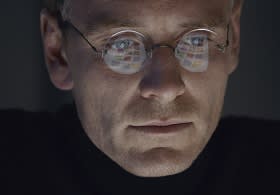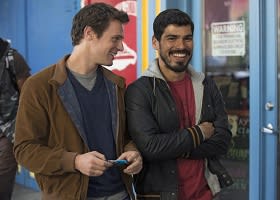Challenges of filming modern San Francisco
The past few years have seen Woody Allen film Blue Jasmine in San Francisco, as well as scenes for Danny Boyle’s Steve Jobs and Gus Van Sant’s When We Rise, but the iconic city faces a struggle to appeal in the face of intense competition.
By Hannah Gal 28 Sep 2016

The past few years have seen Woody Allen film Blue Jasmine in San Francisco, as well as scenes for Danny Boyle’s Steve Jobs (pictured) and Gus Van Sant’s When We Rise, but the iconic city faces a struggle to appeal in the face of intense competition.
In recent years the city has struggled to attract large-scale shoots due to a combination of limited filming incentive support and a lack of studio facilities. Many productions use Vancouver as a more cost-effective double.
“Unfortunately, with the advent of film incentives, California, including San Francisco, lost a lot of production to states and countries which were offering large incentives,” says Susannah Greason Robbins, executive director of the San Francisco Film Commission.
“With the expanded California Film Tax Credit and the rebate programme there are positive signs of productions returning to San Francisco,” she says, stating that the “rise in the number of new media outlets producing their own content, such as Netflix, Hulu, and Amazon” is contributing to “a boom in this type of production.”
Since the spring of this year, San Francisco has hosted Hugh Laurie’s new medical TV drama Chance and scenes from Girlboss and Sense8 – both for Netflix – as well as Amazon’s Budding Prospects.
“We’ve also had independent films shooting recently,” says Robbins. “Some extremely low budget ($25,000) to low budget ($1m), to others a little over $10m.”

As a sign of the limitations of California’s state and local incentive support, while film and TV production has risen in terms of the number of shoots, most are low budget.
High-end dramas and big-budget studio movies still film elsewhere in the US or internationally.
San Francisco’s main incentive for film and television productions, the Scene in San Francisco Rebate Program, is proving effective in attracting independent productions.
The local support programme was “one of the deciding factors for the Steve Jobs film being shot in San Francisco instead of another higher-incentive state,” says Robbins.
The local programme offers a rebate on all fees paid to any city agency up to $600,000 per film or television production, including permit fees, street closure fees and parking lots owned by the city.
“If your budget is for less than $3m you would need to shoot 55% of your shooting days in order to qualify,” Robbins says. “If it’s over $3m, you would need to shoot 65% of your days here.”
San Francisco’s incentives also include national and international airfare discounts and a Vendor Discount Program, which offers discounts from local hotels, restaurants, car rentals and some production services.

HBO drama Looking has been among the higher-profile productions to film in San Francisco. The show lasted two seasons and culminated in a TV movie to tell the story of three young gay men in modern San Francisco. It used the city as a magnificent backdrop.
“Without San Francisco there is no Looking,” says the film’s cinematographer Xavier Peréz Grobét, who speaks of a city “where it is hard to not have a good angle when you’re outdoors.”
Perhaps inevitably, Looking: The Movie feels like a homage to the city which holds a special place of honour in the history of modern cinema.
From The iconic The Graduate and The Streets of San Francisco to Francis Coppola’s The Conversation and Clint Eastwood’s Dirty Harry, San Francisco’s enchanting period rooflines and miles of car-chase-friendly roads have been the background to many cinematic classics.
Grobet photographed Looking’s second TV series and the movie and was inspired by the city’s natural beauty and the cinematographic challenges it has posed.
“We filmed in the city’s real locations except for [protagonist] Patrick’s apartment, which we had built for the run of the two TV seasons we shot. We stayed true to the geography of the city in the film, which in the series plays as the main character.
“The team created a distinctive look that accentuated the colour contrast, pushing yellow into the highlights and adding cyan (a greenish-blue) to the shadows.
“Even though the use of handheld camera ruled for most of the two TV seasons, this time we chose the use of Steadicam for tracking shots of people moving or walking. Once we were into the scene we switched to handheld.”

Grobet’s biggest challenge was shooting indoors. “Sometimes we were in really small spaces or with low ceilings, which had my brain working to figure out a way to approach those situations; sometimes the fog can be a little tricky depending on what part of the city you are in.
“The bar scenes were challenging too. I did make use of the facilities’ lighting rigs and added my own, but one of the bars had a really low black ceiling.
"Somehow I managed to make it work even as the camera moved around the characters. Those locations make you think outside of the box to come up with a smart solution.
“Andrew Haigh is a very visual director too which makes things much more interesting for me because we can communicate with the same language. When blocking a scene he’s always aware of the camera, he builds a choreography of moves between the actors and the camera.”
California now has an annual film fund of $330m to support film and TV shoots. Production is still largely based in and around Los Angeles, but San Francisco will be hoping to attract more high-spending projects in the coming years.
For more on filming in California see our production guide.
Steve Jobs image: Universal Pictures. Looking poster: HBO. Looking image: John P Johnson/HBO
“Unfortunately, with the advent of film incentives, California, including San Francisco, lost a lot of production to states and countries which were offering large incentives,” says Susannah Greason Robbins, executive director of the San Francisco Film Commission.
“With the expanded California Film Tax Credit and the rebate programme there are positive signs of productions returning to San Francisco,” she says, stating that the “rise in the number of new media outlets producing their own content, such as Netflix, Hulu, and Amazon” is contributing to “a boom in this type of production.”
Since the spring of this year, San Francisco has hosted Hugh Laurie’s new medical TV drama Chance and scenes from Girlboss and Sense8 – both for Netflix – as well as Amazon’s Budding Prospects.
“We’ve also had independent films shooting recently,” says Robbins. “Some extremely low budget ($25,000) to low budget ($1m), to others a little over $10m.”

As a sign of the limitations of California’s state and local incentive support, while film and TV production has risen in terms of the number of shoots, most are low budget.
High-end dramas and big-budget studio movies still film elsewhere in the US or internationally.
San Francisco’s main incentive for film and television productions, the Scene in San Francisco Rebate Program, is proving effective in attracting independent productions.
The local support programme was “one of the deciding factors for the Steve Jobs film being shot in San Francisco instead of another higher-incentive state,” says Robbins.
The local programme offers a rebate on all fees paid to any city agency up to $600,000 per film or television production, including permit fees, street closure fees and parking lots owned by the city.
“If your budget is for less than $3m you would need to shoot 55% of your shooting days in order to qualify,” Robbins says. “If it’s over $3m, you would need to shoot 65% of your days here.”
San Francisco’s incentives also include national and international airfare discounts and a Vendor Discount Program, which offers discounts from local hotels, restaurants, car rentals and some production services.

HBO drama Looking has been among the higher-profile productions to film in San Francisco. The show lasted two seasons and culminated in a TV movie to tell the story of three young gay men in modern San Francisco. It used the city as a magnificent backdrop.
“Without San Francisco there is no Looking,” says the film’s cinematographer Xavier Peréz Grobét, who speaks of a city “where it is hard to not have a good angle when you’re outdoors.”
Perhaps inevitably, Looking: The Movie feels like a homage to the city which holds a special place of honour in the history of modern cinema.
From The iconic The Graduate and The Streets of San Francisco to Francis Coppola’s The Conversation and Clint Eastwood’s Dirty Harry, San Francisco’s enchanting period rooflines and miles of car-chase-friendly roads have been the background to many cinematic classics.
Grobet photographed Looking’s second TV series and the movie and was inspired by the city’s natural beauty and the cinematographic challenges it has posed.
“We filmed in the city’s real locations except for [protagonist] Patrick’s apartment, which we had built for the run of the two TV seasons we shot. We stayed true to the geography of the city in the film, which in the series plays as the main character.
“The team created a distinctive look that accentuated the colour contrast, pushing yellow into the highlights and adding cyan (a greenish-blue) to the shadows.
“Even though the use of handheld camera ruled for most of the two TV seasons, this time we chose the use of Steadicam for tracking shots of people moving or walking. Once we were into the scene we switched to handheld.”

Grobet’s biggest challenge was shooting indoors. “Sometimes we were in really small spaces or with low ceilings, which had my brain working to figure out a way to approach those situations; sometimes the fog can be a little tricky depending on what part of the city you are in.
“The bar scenes were challenging too. I did make use of the facilities’ lighting rigs and added my own, but one of the bars had a really low black ceiling.
"Somehow I managed to make it work even as the camera moved around the characters. Those locations make you think outside of the box to come up with a smart solution.
“Andrew Haigh is a very visual director too which makes things much more interesting for me because we can communicate with the same language. When blocking a scene he’s always aware of the camera, he builds a choreography of moves between the actors and the camera.”
California now has an annual film fund of $330m to support film and TV shoots. Production is still largely based in and around Los Angeles, but San Francisco will be hoping to attract more high-spending projects in the coming years.
For more on filming in California see our production guide.
Steve Jobs image: Universal Pictures. Looking poster: HBO. Looking image: John P Johnson/HBO
Latest news & features
Featured profiles
Promote your services with KFTV
Choose from three profile types - Basic, Silver and Gold
Create ProfileWe offer a range of display advertising opportunities.
Learn More